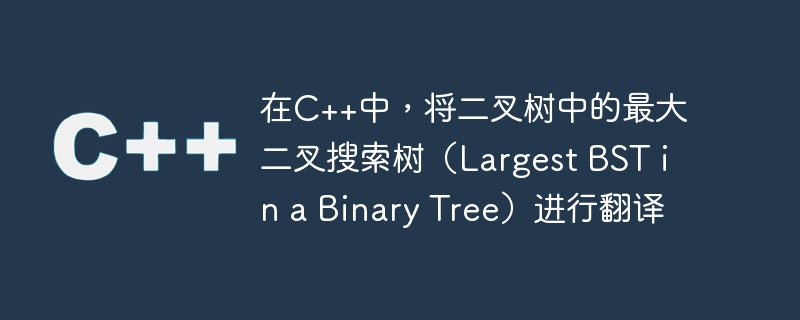在C++中,將二元樹中的最大二元搜尋樹(Largest BST in a Binary Tree)進行翻譯
- PHPz轉載
- 2023-09-13 16:29:04955瀏覽

在二元樹中,每個子節點只有兩個節點(左和右)。樹結構只是資料的表示。二元搜尋樹(BST)是滿足這些條件的特殊類型的二元樹-
-
與與其父節點相比,左子節點較小
右子節點的父節點比子節點大
假設給定一棵二元樹,我們有應該找出其中最大的二元搜尋樹(BST)。
在此任務中,我們將建立一個函數來尋找二元樹中最大的 BST。當二元樹本身是BST時,就可以確定整個二元樹的大小。舉個例子 -
輸入
10 /\ 5 15 /\ \ 1 8 7
如圖所示,在本例中突出顯示的 BST 子樹是最大的。 '3' 是子樹的大小,因此傳回值是子樹的大小。
輸入
52
/ \
37 67
/\ / \
12 27 57 77
/\
72 87輸出
#5
節點長度小於其父節點長度的子樹最多具有三個大小的BST 節點。
尋找給定二元樹中最大 BST 的方法
對於每個節點 x,如果下列點有效,則二元樹是 BST。只有資料小於其父節點資料的節點才會出現在節點的左子樹。只能有一個節點比其父節點擁有更多資料。左子樹和右子樹都應該用二元搜尋樹(BST)來表徵。
演算法將是 -
我們將從二元樹並使用遞歸進行中序遍歷。對於當前節點“ROOT”,我們將執行以下操作 -
如果它是有效 BST 的根,我們將返回其大小。
否則,我們將在左右子樹中找到最大的 BST。
範例
#include <bits/stdc++.h>
using namespace std;
struct Node {
int data;
struct Node *left;
struct Node *right;
};
struct Node *
newNode (int data) {
struct Node *node = new Node;
node->data = data;
node->left = node->right = NULL;
return (node);
}
struct Detail {
int size;
int max;
int min;
int ans;
bool isBST;
};
bool isBST (Node * root, int min, int max) {
if (root == NULL) {
return true;
}
if (root->data < min || root->data > max) {
return false;
}
return isBST (root->left, min, root->data - 1) &&
isBST (root->right, root->data + 1, max);
}
int size (Node * root) {
if (root == NULL) {
return 0;
}
return 1 + size (root->left) + size (root->right);
}
int largestBST (Node * root) {
// Current Subtree is BST.
if (isBST (root, INT_MIN, INT_MAX) == true) {
return size (root);
}
// Find largest BST in left and right subtrees.
return max (largestBST (root->left), largestBST (root->right));
}
int main () {
struct Node *root = newNode (67);
root->left = newNode (72);
root->right = newNode (77); root->left->left = newNode (57);
printf ("Size of the largest BST is %d", largestBST (root));
return 0;
}輸出
Size of the largest BST is 2
#結論
在這個問題中,我們了解了什麼是二元樹和二元搜尋樹,以及如何借助遞歸找出給定二元樹中最大的BST。借助遞歸,我們將找出每個節點下的子樹是否為 BST,並傳回對應的值。
以上是在C++中,將二元樹中的最大二元搜尋樹(Largest BST in a Binary Tree)進行翻譯的詳細內容。更多資訊請關注PHP中文網其他相關文章!
陳述:
本文轉載於:tutorialspoint.com。如有侵權,請聯絡admin@php.cn刪除

